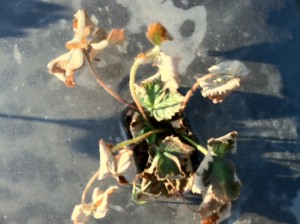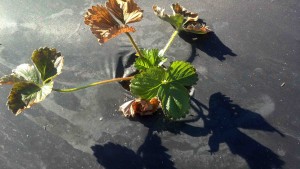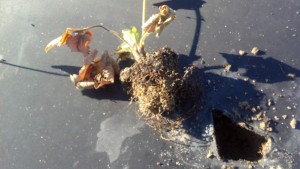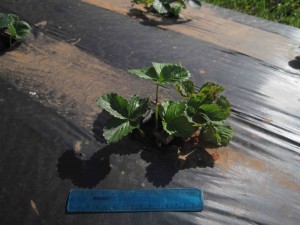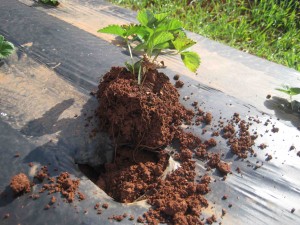Strawberry Roots Are Very Sensitive to Dryness and Salinity (11.5.12)
go.ncsu.edu/readext?3163
en Español / em Português
El inglés es el idioma de control de esta página. En la medida en que haya algún conflicto entre la traducción al inglés y la traducción, el inglés prevalece.
Al hacer clic en el enlace de traducción se activa un servicio de traducción gratuito para convertir la página al español. Al igual que con cualquier traducción por Internet, la conversión no es sensible al contexto y puede que no traduzca el texto en su significado original. NC State Extension no garantiza la exactitud del texto traducido. Por favor, tenga en cuenta que algunas aplicaciones y/o servicios pueden no funcionar como se espera cuando se traducen.
Português
Inglês é o idioma de controle desta página. Na medida que haja algum conflito entre o texto original em Inglês e a tradução, o Inglês prevalece.
Ao clicar no link de tradução, um serviço gratuito de tradução será ativado para converter a página para o Português. Como em qualquer tradução pela internet, a conversão não é sensivel ao contexto e pode não ocorrer a tradução para o significado orginal. O serviço de Extensão da Carolina do Norte (NC State Extension) não garante a exatidão do texto traduzido. Por favor, observe que algumas funções ou serviços podem não funcionar como esperado após a tradução.
English
English is the controlling language of this page. To the extent there is any conflict between the English text and the translation, English controls.
Clicking on the translation link activates a free translation service to convert the page to Spanish. As with any Internet translation, the conversion is not context-sensitive and may not translate the text to its original meaning. NC State Extension does not guarantee the accuracy of the translated text. Please note that some applications and/or services may not function as expected when translated.
Collapse ▲Over the weekend, I received this photo of a very stressed looking 4-5 week old Chandler plug (taken in a South Carolina field). And, this was the note that accompanied the picture:
Hey Dr. Poling,
I have a local grower who contacted me regarding some plant issues that he is dealing with. It seems that he is experiencing some large losses in his Chandler planting – he also has Camarosa and Sweet Charlie, but doesn’t see any issues in those. Symptoms include plant death, some necrotic foliage, and some foliar edge browning. The plant source is from Balamore and I grew out the plugs. The plants from this particular lot were tested and the tips/plugs tested clean without any problems. These plants have been in the ground for about 4-5 weeks. I have attached some pictures for you. Are you hearing of any issues this fall or have any suggestions? The grower told me that he would bring some plant tissue to the expo this week and hopefully have you, Frank, or someone take a look and possibly take them back to the lab for testing.
Thanks,
Eric
Today (Monday), I got another email from Eric saying that he also contacted Clemson’s Plant Pathologist, Dr. Guido Schnabel. Dr. Schnabel obtained some plant samples late this morning and apparently did not see anything that looked like anthracnose or P. cactorum, according to the grower. Kevin then wrote, “It’ll be interesting to see what this turns out to be.” <Editor’s note: I don’t mean to jump the gun, but I have a sneaking suspicion that we could be looking at a problem with dry beds and possible salinity issues>
A call from Bob Rouse in Maryland today (Nov. 5): What I did not tell Eric Hunter after receiving his photo (of a 4-5 week old Chandler plug in SC), was that I went ahead and copied it to Bob Rouse, retired Extension Specialist and strawberry consultant, who has been seeing similar things up in Maryland! Do you recall this advisory on 10.22.12 on the Portal?
“Today, I received these photos (below) from a grower where plug establishment in one Chandler block has not been going as well as hoped. Samples of these plants have been sent off to a Plant Diagnostic lab to check for possible salt damage as well as to see if there is a potential disease issue. However, in speaking with the producer it was learned that there has not been any irrigation over the last 10 days (and, it has been very dry), and the problem seems to be worse in sandier areas of the field. You can probably see there has not been much new rooting in recent days, and given that it has been very dry, I would not lose any time in giving these plants a “good drink” right away. I recall that back in the falls of 2006 and 2007 we were very dry all over the state of NC, and in sandier soils where drip irrigation had not been hooked up, you could see plants looking just like the ones in the 3rd and 4th photos. Dr. Powell Smith, Clemson, communicated to me today that, “…many burned leaves makes you think salts. A 2:1 water to media extract should read no higher than 0.70 mmhos on an EC meter. Over 1.0 would certainly indicate problems.”
Well, when Bob Rouse called me tonight to respond to the photo I sent to him of the South Carolina “stressed” Chandler plug, here is what he had to say:
” Barclay re: those (SC) plants… it looks to me like salt injury or lack of moisture with the leaves scorched back. Its possible that the roots did not get out into the soil well and they did not irrigate enough. We were reasonably dry until the hurricane in some fields. If its a sandy soil site and it dried out just enough the leaves could scorch back.”
Bob also informed me that AS OF TODAY, THESE STRESSED CHANDLER PLUGS (in MD) ARE RECOVERING AND HAVE NICE GREEN GROWING POINTS . Intensive drip irrigation was the key to their recovery!
Chandler plugs in Johnston County Reported to Have Same Symptoms Today! Well, unlike Maryland, we did not see that much rain from Sandy in inland areas last week. And, we have been very dry! Don’t let those aisle areas fool you either! It is possible to get “little showers” and have the soil in the aisles seem moist, but beneath the plastic film it’s still very dry. As of today I got reports of two Chandler plantings in Johnston County with similar symptoms (leaves scorched back). In one field, the grower had Chandler plants from 2 different Canadian nurseries (one in Nova Scotia and the other PEI), and they were both exhibiting identical scorching symptoms. The same symptoms were observed on one farm in both plugs or fresh dugs.
I would have to do more investigating on actual precipitation patterns when Chandler plants were being set this year, but I thought it was very interesting that both Bob Rouse in Maryland and the person who contacted me about similar looking Chandler plants in Johnston County, both commented how the Sweet Charlie and Camarosa plants set a full week earlier, were looking fine. And, isn’t it interesting how Eric Hunter (SC) commented, “I have a local grower who contacted me regarding some plant issues that he is dealing with. It seems that he is experiencing some large losses in his Chandler planting – he also has Camarosa and Sweet Charlie, but doesn’t see any issues in those.”
Field visits in Alamance County on Thursday (Nov 1). I know it is getting late, and I am probably keeping you from some very exciting presidential election reports on TV, but I thought I would end this advisory with a photo of Chandler plugs I saw last Thursday in Alamance County that had very good top growth, and when we dug up this same plant we observed roots that were 9 inches deep! These Chandler plugs were set on 9/25, and had good drip irrigation all through the month of October (photo 11/1/12 — 6 inch ruler on plastic to help you gauge plant size).
The Bottom-line: Newly developing strawberry roots are very sensitive to dryness and salinity, and frequent drip irrigations in October and early November may be necessary during dry spells. In other growing areas like California, careful water management is a very high priority during the first 4 weeks of establishment (the window we are in right now), and I think it needs to be a very high priority across the our region as well!
If you wish to see how Chandler plugs set on the same day looked in another field the same day (in another part of the same county), just take a look at these final few shots. In this situation the grower “got busy” in other things after planting.



